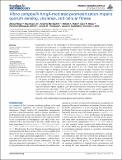Vibrio campbellii hmgA-mediated pyomelanization impairs quorum sensing, virulence, and cellular fitness
Author(s)
Wang, Zheng; Lin, Baochuan; Mostaghim, Anahita; Rubin, Robert A.; Glaser, Evan R.; Mittraparp-arthorn, Pimonsri; Vuddhakul, Varaporn; Vora, Gary J.; Thompson, Janelle Renee; ... Show more Show less
DownloadWang-2013-Vibrio campbellii hm.pdf (1.925Mb)
PUBLISHER_POLICY
Publisher Policy
Article is made available in accordance with the publisher's policy and may be subject to US copyright law. Please refer to the publisher's site for terms of use.
Terms of use
Metadata
Show full item recordAbstract
Melanization due to the inactivation of the homogentisate-1,2-dioxygenase gene (hmgA) has been demonstrated to increase stress resistance, persistence, and virulence in some bacterial species but such pigmented mutants have not been observed in pathogenic members of the Vibrio Harveyi clade. In this study, we used Vibrio campbellii ATCC BAA-1116 as model organism to understand how melanization affected cellular phenotype, metabolism, and virulence. An in-frame deletion of the hmgA gene resulted in the overproduction of a pigment in cell culture supernatants and cellular membranes that was identified as pyomelanin. Unlike previous demonstrations in Vibrio cholerae, Burkholderia cepacia, and Pseudomonas aeruginosa, the pigmented V. campbellii mutant did not show increased UV resistance and was found to be ~2.7 times less virulent than the wild type strain in Penaeus monodon shrimp virulence assays. However, the extracted pyomelanin pigment did confer a higher resistance to oxidative stress when incubated with wild type cells. Microarray-based transcriptomic analyses revealed that the hmgA gene deletion and subsequent pyomelanin production negatively effected the expression of 129 genes primarily involved in energy production, amino acid, and lipid metabolism, and protein translation and turnover. This transcriptional response was mediated in part by an impairment of the quorum sensing regulon as transcripts of the quorum sensing high cell density master regulator LuxR and other operonic members of this regulon were significantly less abundant in the hmgA mutant. Taken together, the results suggest that the pyomelanization of V. campbellii sufficiently impairs the metabolic activities of this organism and renders it less fit and virulent than its isogenic wild type strain.
Date issued
2013-12Department
Massachusetts Institute of Technology. Department of Civil and Environmental EngineeringJournal
Frontiers in Microbiology
Publisher
Frontiers Research Foundation
Citation
Wang, Zheng, Baochuan Lin, Anahita Mostaghim, Robert A. Rubin, Evan R. Glaser, Pimonsri Mittraparp-arthorn, Janelle R. Thompson, Varaporn Vuddhakul, and Gary J. Vora. “Vibrio Campbellii hmgA-Mediated Pyomelanization Impairs Quorum Sensing, Virulence, and Cellular Fitness.” Frontiers in Microbiology 4 (2013).
Version: Final published version
ISSN
1664-302X